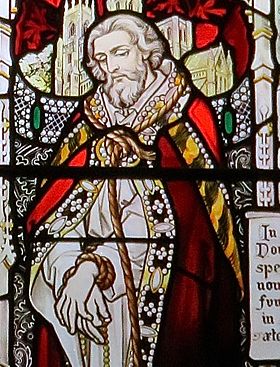Richard Simpson (martyr) facts for kids
Quick facts for kids BlessedRichard Simpson |
|
|---|---|

Stained glass window in St. Mary's Roman Catholic Church in Bridge Gate, Derby.
|
|
| Priest and Martyr | |
| Born | c. 1553 Well in Yorkshire |
| Died | 24 July 1588 (aged 34 - 35) St Mary's Bridge in Derby |
| Venerated in | Roman Catholic Church |
| Beatified | 22 November 1987 by John Paul II |
| Feast | 24 July and 22 November |
| Attributes | bound hands, noose in neck |
Richard Simpson (born around 1553, died July 24, 1588) was an English priest. He became a martyr during the time of Queen Elizabeth I. He was born in Well, a village in Yorkshire, England.
Not much is known about his early life. He was first a priest in the Church of England. However, he later chose to become a Catholic priest.
Because he was Catholic, he was put in prison in York. After he was released, he went to Douai College in France in 1577. He became a Catholic priest in Brussels and returned to England. He worked as a missionary priest in Lancashire and Derbyshire.
Contents
Arrest and Trials
In 1585, Richard Simpson was arrested and sent out of England. But he quickly came back to continue his work. In January 1588, while traveling, he met a man who pretended to be Catholic. Simpson trusted him and told him he was a priest. The man then reported him to the authorities.
Simpson was arrested and put in prison in Derby. He was sentenced to death for treason. This was because being a Catholic priest was against the law at that time. However, his execution was delayed for a few months.
Why Was His Execution Delayed?
Some stories say that Richard Simpson might have hinted he would attend a Protestant church service. This could have been why his execution was put on hold. However, there is no proof that he actually did this.
Another idea is that Queen Elizabeth I and her government stopped executing priests for a while. This happened in late 1587 and early 1588. They might have done this to avoid upsetting King Philip II of Spain. He was preparing his fleet to attack England. By July 1588, the Armada was on its way. So, there was no longer a reason to spare priests. Richard Simpson and his friends were among the first of many priests executed that year.
Meeting Other Priests
While in Derby prison, Richard Simpson met two other Catholic priests. Their names were Nicholas Garlick and Robert Ludlam. It is believed that they helped Simpson strengthen his Catholic faith.
At his second trial on July 23, 1588, Simpson bravely declared he was a Catholic. He was sentenced to death along with Garlick and Ludlam. Their execution was set for the next day.
Execution and Legacy
On July 24, 1588, the three priests were taken to St Mary's Bridge in Derby. They were executed by hanging, drawing and quartering. This was a very harsh form of punishment.
Richard Simpson was supposed to be executed first. But Nicholas Garlick quickly went to the ladder before him. Some say this was because Simpson seemed a bit scared. Others say Garlick worried Simpson's courage might fail. An eyewitness said that Simpson "suffered with great constancy." When his body was cut down, people found he was wearing a hairshirt. This was a rough garment worn for religious reasons.
Richard Simpson and his two companions were recognized as venerable in 1888. They were among the eighty-five martyrs of England and Wales. They were officially beatified (declared "Blessed") by Pope John Paul II on November 22, 1987.
See also

